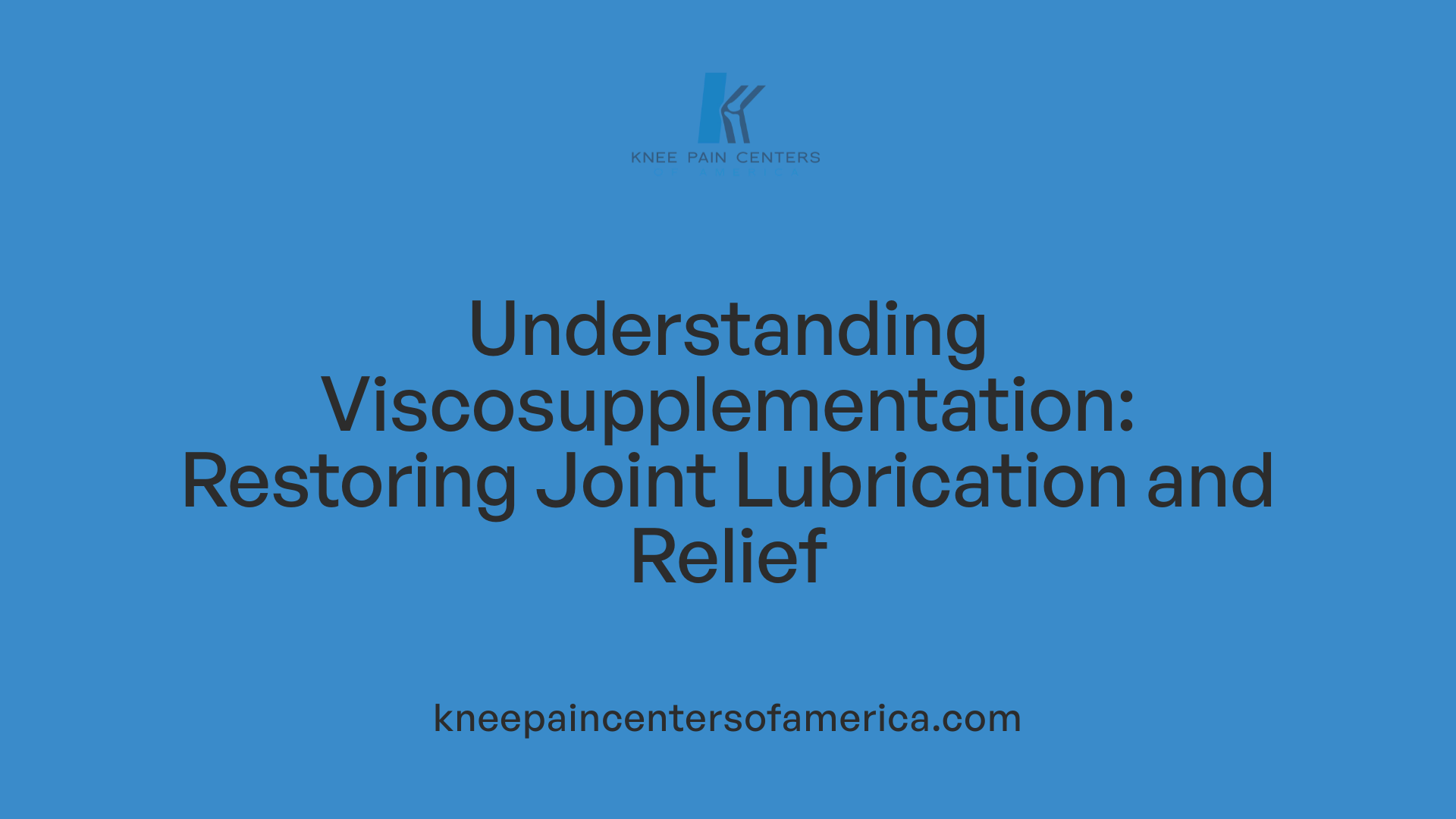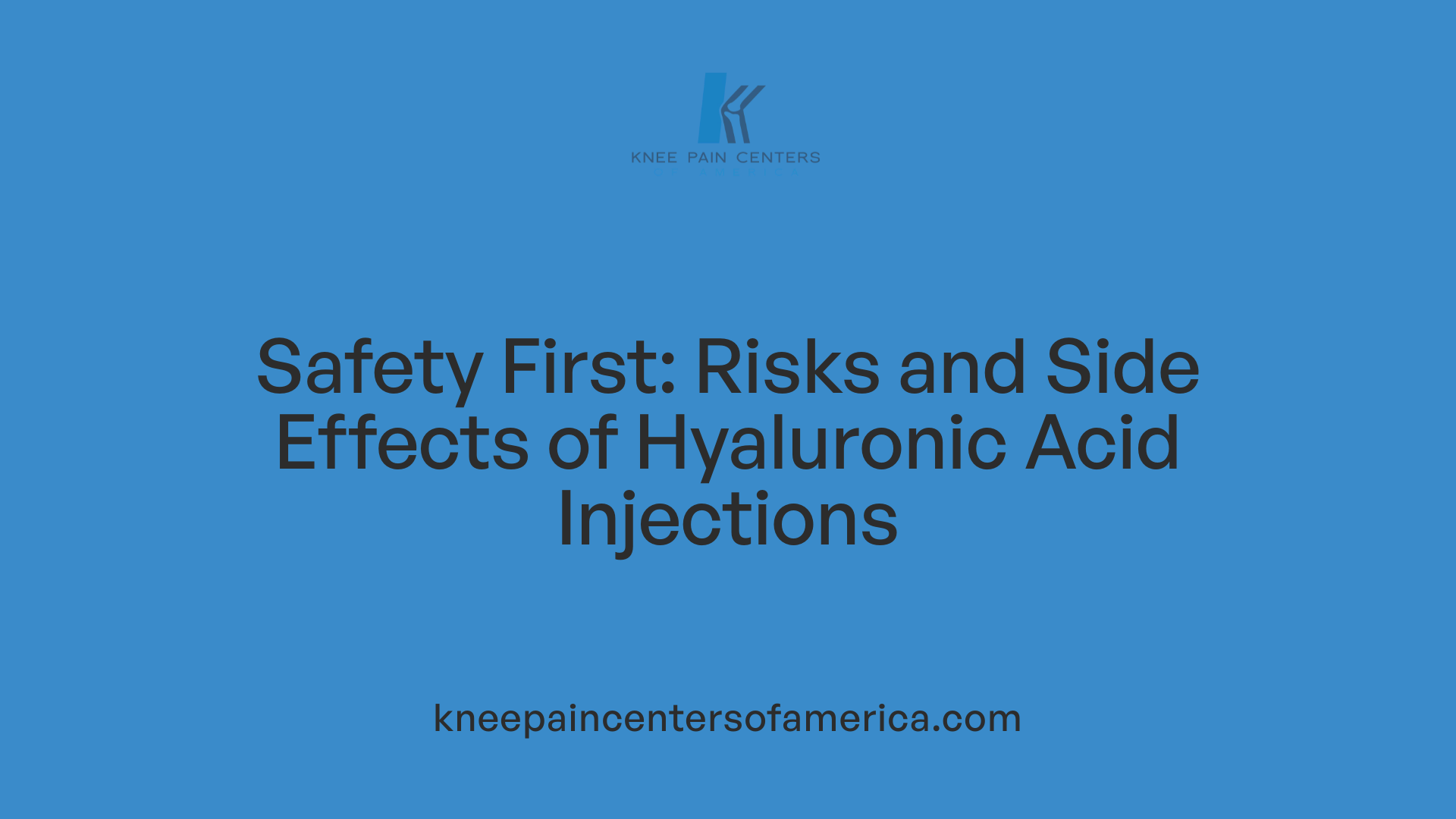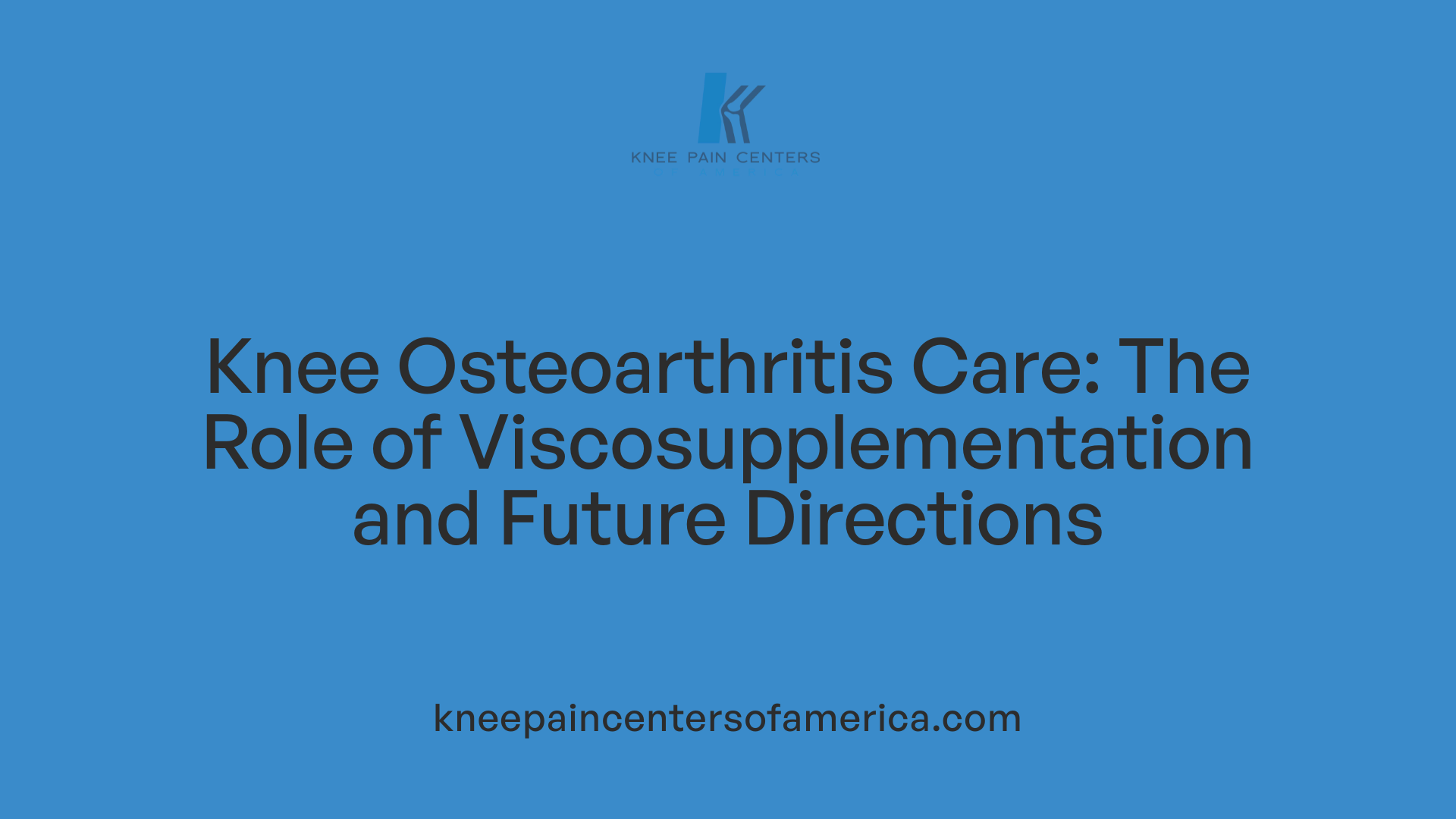Understanding Viscosupplementation as a Conservative Treatment
Osteoarthritis (OA) affects millions worldwide, leading to joint pain, stiffness, and reduced mobility. Among non-surgical interventions, viscosupplementation has emerged as a minimally invasive procedure aimed at alleviating symptoms, especially in patients with mild to moderate osteoarthritis. This article explores the concept, procedure, effectiveness, safety, and specific role of viscosupplementation in managing knee osteoarthritis, providing patients and clinicians with a comprehensive overview.
What is Viscosupplementation and Its Purpose in Osteoarthritis Treatment

What is viscosupplementation and what is its purpose in osteoarthritis treatment?
Viscosupplementation is a medical procedure that involves injecting hyaluronic acid (HA) directly into the affected joint, most commonly the knee, to help restore the joint’s natural properties. Hyaluronic acid is a key component of synovial fluid, which lubricates and cushions the joints, allowing for smooth movement.
In osteoarthritis (OA), the levels and quality of hyaluronic acid in the joint decrease. This reduction results in less effective lubrication and shock absorption, leading to symptoms like joint pain, stiffness, and swelling.
The primary goal of viscosupplementation is to supplement the body’s declining hyaluronic acid to improve these functions. By increasing the viscosity and elasticity of the synovial fluid, this treatment helps reduce friction within the joint, alleviating pain and enhancing mobility.
Most patients receive a series of injections, often weekly over several weeks. Although it does not reverse the damage caused by osteoarthritis, viscosupplementation can provide symptom relief that lasts several months. It is especially useful for individuals with early to moderate osteoarthritis who have not responded well to other nonsurgical treatments.
This minimally invasive, low-risk procedure can delay the need for more invasive interventions like joint replacement surgery. Overall, viscosupplementation supports better joint function and an improved quality of life by helping the cartilage move more freely and reducing joint pain.
How Viscosupplementation Is Performed
Preparation for injection
Before the procedure, the healthcare provider thoroughly cleans the skin over the affected joint, often the knee, to prevent infection. Patients may be asked to inform their provider about current medications, allergies, and any recent health issues. In some cases, excess joint fluid may be aspirated to improve injection accuracy and reduce swelling. A local anesthetic may be applied to numb the area, minimizing discomfort during the injection.
Use of imaging guidance
Imaging techniques such as ultrasound or X-ray are commonly used to locate the precise position of the joint space, especially in complex cases or when anatomical landmarks are difficult to identify. This guidance helps ensure the hyaluronic acid is accurately delivered into the joint, improving the effectiveness of the treatment.
Steps involved in the procedure
The procedure typically involves several steps:
- The patient is positioned comfortably, usually lying down.
- The injection site is sterilized with antiseptic solution.
- If needed, local anesthesia is administered.
- Using a fine needle attached to a syringe, the healthcare provider injects the hyaluronic acid, a gel-like substance that acts as a lubricant and shock absorber.
- In some cases, multiple injections are given a week apart, depending on the product used and the treatment plan.
- A bandage or ice pack may be applied following the injection.
Post-procedure care and precautions
After the injection, patients are advised to rest and avoid strenuous activities for at least 48 hours. Using ice packs can help reduce swelling and discomfort. It is common to experience mild pain, warmth, or swelling at the injection site, which usually subsides quickly. Patients should follow their provider’s instructions regarding activity levels and medications.
Most individuals can resume normal activities within a day or two. The beneficial effects of viscosupplementation typically appear gradually over a few weeks and may last several months, with repeated injections considered as needed, generally after about six months.
Candidates, Efficacy, and Clinical Evidence

What are the indications and criteria for patients to receive viscosupplementation?
Candidates for viscosupplementation are typically individuals with mild to moderate osteoarthritis who have not experienced sufficient relief from conservative options such as non-steroidal anti-inflammatory drugs (NSAIDs), physical therapy, weight management, or corticosteroid injections. The procedure is especially suitable for those seeking to delay or avoid joint replacement surgery, as it targets symptoms related to cartilage breakdown and reduced hyaluronic acid levels within the joint.
Prior to treatment, healthcare providers assess the patient for contraindications, which include active joint infections, hypersensitivity to hyaluronic acid products, or other medical issues like bacteremia. Repeated injections might be necessary for sustained symptom relief, with effectiveness lasting several months. Overall, viscosupplementation is considered safe when used appropriately, but its benefits can vary depending on individual conditions and the stage of osteoarthritis.
How effective is viscosupplementation in managing osteoarthritis?
Scientific studies and systematic reviews show that viscosupplementation with hyaluronic acid provides only small improvements in pain and joint function for osteoarthritis patients, predominantly in the knee. Large, placebo-controlled trials involving thousands of participants have found that since 2009, the actual benefits are not clinically significant, with some analyses indicating that hyaluronic acid injections are statistically comparable to placebo in pain relief.
There is also a concern about increased risks of serious adverse events, although these are rare. The modest benefits are more noticeable in early or less severe stages of osteoarthritis, and the relief often lasts around six months. Due to these factors, current evidence suggests caution in broadly recommending viscosupplementation solely for symptom management, and it is generally reserved for select patients after careful evaluation.
Duration of relief and repeat treatments
The symptomatic relief from viscosupplementation can last from 6 to 12 months. Many patients opt for repeat injections after this period to maintain symptom control. The decision to administer additional treatments depends on individual response, disease progression, and patient preferences.
Research findings and clinical trials
A substantial body of research, including meta-analyses of nearly 9,000 participants and over 20,000 patients in randomized trials, indicates that the effectiveness of viscosupplementation is limited. Since 2009, evidence has accumulated showing that hyaluronic acid injections do not outperform placebo in meaningful pain reduction. Moreover, some studies point to potential harm, with increased risks of serious adverse effects compared to placebo.
Overall, while some patients report improvements with viscosupplementation, the overall clinical benefit is modest at best, and the evidence does not strongly support its routine use for osteoarthritis symptom relief. Current research recommends further investigations to determine which subsets of patients might benefit most and to optimize treatment protocols.
Safety, Risks, and Side Effects

What are the safety considerations, risks, and side effects associated with viscosupplementation?
Viscosupplementation using hyaluronic acid (HA) injections is widely regarded as a safe procedure for treating osteoarthritis, especially of the knee. The majority of side effects are mild, temporary, and localized to the injection site. Patients often report soreness, discomfort, or mild swelling shortly after the injection, which usually resolves within one to two days.
Rare complications can include allergic reactions, local inflammation, or infections such as septic arthritis, although these are extremely uncommon. Another rare adverse event is pseudoseptic reaction — a severe inflammatory response presenting as joint redness, swelling, and pain, which generally improves with rest, ice, and supportive care.
Some patients experience a brief worsening of symptoms soon after the procedure, like increased joint pain or swelling, yet these are typically self-limiting.
To ensure safety, healthcare providers perform careful screening before the injection. Patients are advised to disclose any allergies, recent infections, or skin infections around the injection site, as well as their medication and health history. Proper aseptic techniques and use of imaging guidance when necessary help minimize the risk of infection and other adverse events.
Strategies to reduce risks include pre-procedure evaluation, using the correct injection technique, and providing post-injection care instructions. Patients are usually advised to rest and avoid strenuous activities for at least 24 to 48 hours following the injection; this reduces the likelihood of flare-up symptoms or complication development. Overall, with appropriate precautions, viscosupplementation remains a safe and well-tolerated treatment option for many individuals with osteoarthritis.
Role in Knee Osteoarthritis Management and Future Perspectives

What is the role of viscosupplementation specifically in knee osteoarthritis management?
Viscosupplementation holds a notable position in the treatment approach to knee osteoarthritis, primarily aimed at alleviating pain and improving joint function. This procedure involves injecting hyaluronic acid directly into the knee joint to replenish the viscoelastic properties lost due to cartilage breakdown.
Hyaluronic acid acts as a natural lubricant and shock absorber, helping to reduce friction during joint movement. Its supplementation can lead to decreased pain, increased mobility, and potentially delay the progression of osteoarthritis. The treatment typically involves a series of injections over several weeks, with most patients experiencing benefits lasting from 6 to 12 months.
While some clinical studies support its use, the overall evidence on efficacy is mixed, with meta-analyses indicating small to moderate pain relief. The safety profile of viscosupplementation is generally excellent, with mild side effects such as soreness or swelling at the injection site. It is especially valuable for patients with mild to moderate knee osteoarthritis who have found limited success with other non-invasive treatments like physical therapy, NSAIDs, or corticosteroids.
In summary, viscosupplementation plays a role in improving quality of life for knee OA patients by providing symptomatic relief and helping to maintain joint function, especially when other treatments are insufficient or contraindicated.
Summary and Future Directions in Osteoarthritis Treatment
Viscosupplementation remains a viable non-surgical option for managing mild to moderate osteoarthritis, particularly in the knee. Its ability to temporarily improve joint lubrication and reduce pain offers benefits for selected patients, especially those seeking to delay or avoid surgery. However, current evidence indicates that its efficacy is modest, with benefits comparable to placebo in large clinical trials, and potential risks must be carefully considered. Ongoing research continues to evaluate optimal patient selection, injection protocols, and long-term effects. As our understanding of osteoarthritis progresses, viscosupplementation may be integrated more effectively into personalized treatment plans, complementing other medical and physical therapies to enhance patient outcomes.
References
- A Comprehensive Review of Viscosupplementation in Osteoarthritis ...
- Viscosupplementation Treatment for Arthritis - UMass Memorial Health
- Viscosupplementation Treatment for Knee Arthritis - OrthoInfo
- Viscosupplementation for Osteoarthritis: a Primer for Primary Care ...
- Viscosupplementation for Treatment of Arthritis - Main Line Health
- What to Know About Knee Gel Injections (Viscosupplementation)
- VISCOSUPPLEMENTATION FOR OSTEOARTHRITIS
- Viscosupplementation for knee osteoarthritis: systematic review and ...





